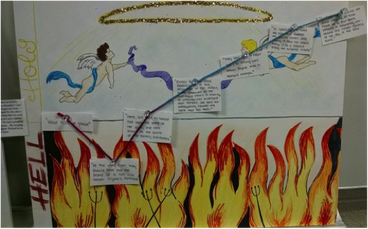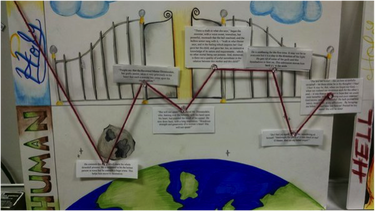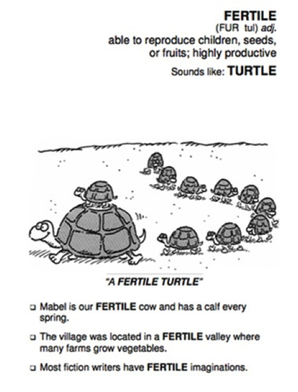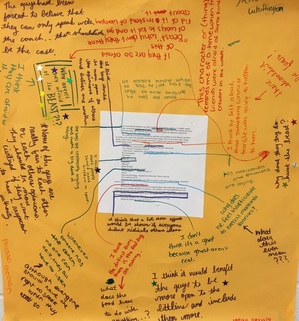|
By Jeni Gearhart I like color (and coloring books but that is beside the point). My classroom is covered in color from student projects. On occasion, my teaching wardrobe is too colorful. I say all of this because in the last few years, I have discovered the importance of visual argument in the classroom. Much of this new love of visual has come from AP workshops and creative teacher friends that I follow on Twitter. So, why is this important? If we use visuals well, it can become more than making a project “pretty”. It should be a part of the argument itself. In an increasingly visual society, students should be learning how to use the medium well (and understand how others are using it to influence them). Here are two things that I used this year that worked well. The first is low tech (hello art supplies!). The second is high tech but can be managed with art supplies if computers are inaccessible. Literary Fever Chart I originally read about this strategy in Write Like This by Kelly Gallagher (side note: if you haven’t read this book, find it now. His books are gold mines of great ideas). Essentially, a fever chart is a quote analysis that morphs into an analysis of a large theme in a text. It takes its original concept from medical fever charts documenting an individual’s changes in body temperature. For our purposes, it charts a character’s development. I used this in both my AP Language class and my sophomore class this year. In both cases, the students really got into it. This strategy works best to analyze the development of a theme over the course of a story, specifically in relation to an individual character. In my lesson from The Scarlet Letter, students chose one of the main characters (Hester, Dimmesdale, or Chillingworth) and charted the character’s move toward (or attitude towards) redemption (good) and damnation (evil). Here are the basic instructions:
We did this over the course of a few days at the end of the novel, but I think it would be even better to introduce at the beginning of the novel and carry through. Variations could involve tracking the use of a particular symbol or even a particular kind of word. I’ve also had students chart multiple characters on the same chart. Why I like this:
Infographics Most simply, an infographic is a visual image such as a chart or diagram used to represent information or data. They use text combined with symbols and intentional color/sizing. This has become a pretty prevalent visual medium. Here is an example if you’re not sure what I’m talking about. I first started thinking about ways to use infographics after reading this article a couple of years ago. I experimented with some low tech options and then discovered some great websites that make this project stand out. I wanted the infographics to be more than a poster project. They had to create a visual argument. As such, I have a few very basic requirements when we create infographics:
Read more about my students' infographics after the jump...
2 Comments
Summertime and the Learning's Easy: Strategies & Resources to Take Back to Your Classrooms6/23/2016 
by Karla Hilliard
Oh sweet summertime. That beloved teacher time-of-year to hit the brakes and relax, to put your toes in the water and your mind on neutral, to sleep in until noon and binge on Netflix until whenever, and of course, to fulfill the English teacher dream of savoring the stockpile of books you’ve been waiting to relish in the sunshine. But we all know that a teacher’s summer is much more than boat drinks and binge watching. Most educators I know are thinking ahead to next year. They are seeking out new professional texts, tweaking their syllabi, attending or presenting at workshops and conferences, collaborating with colleagues, and engaging in online PD. They dedicate plenty of their summer breaks to developing their craft and discovering new ways to engage their students and to become better, stronger, more effective teachers. In the spirit of the crazy-awesome-amazing-inspiring dedication of teachers everywhere, here are some of my favorite activities and resources you can take back to your classrooms next fall
For Close-Reading & Analysis
Do yourself a favor and take 15 minutes and watch 2010 National Teacher of the Year Sarah Brown Wessling work her magic in an English 12 class. Her Observe, Find Patterns, Draw Conclusions approach is applicable to any genre of text and any level of student. The kind of thinking this strategy requires is solid, and it nudges students towards identifying the complexity of a work. The best part? The students do the heavy lifting – they develop an intimacy with the text, probe for ideas, and construct meanings. Meanwhile, you use your expertise to coach and guide. Trust me: it’s good. For Mentor Texts & Literary Analysis As an AP Literature teacher, I’m constantly searching for ways to elevate students’ writing, specifically analysis. Literary analysis is a sticky wicket of an essay. It’s so easy for students to slip into that “sounding smart” voice or and crank out five neat and orderly paragraphs and call it a day. Teacher and author Rebekah O’Dell of Writing With Mentors pitches a genius idea utilizing current, engaging mentor texts (think The New Yorker and The Atlantic) modeling analysis. It makes so much sense! See what she has to say HERE. You’ll be glad you did. For Novelty & Creativity I came across a lovely article on Twitter that said when you’re a teacher you learn that, “An idea you had five minutes before class will be such a hit that your kids learn like crazy and talk about it for months afterward.” This happened to me, and I wrote it about it HERE. The long and short of it is this: poetry + a table of craft supplies + theme analysis + a time limit. I called it the Quickfire Challenge a la Top Chef, and it’s been serving up some mean analysis ever since. For Formative Assessment I confess: I’m a sucker for a listicle. But this ain’t no mindless Buzzfeed click-bait. Click HERE to check out the plentiful ideas provided by Todd Finley on Edutopia. (Todd, by the way, has an excellent newsletter called Todd’s Brain. Click here to check it out.) In this article, you’ll find a brief discussion of formative and summative assessments and 53 (fifty-three!) quick and easy ways to assess your students’ understanding. And if you’re feeling wicked, you can have a student choose an activity from the list to assign to the class. Bwahaha! For Shakespeare Brian Sztabnik of Talks With Teachers is a genius. HERE is his Shakespearean Musical Chairs -- a fun, engaging, and adaptable activity that makes for meaningful instruction. Try it out, and make sure to create your own Shakespearean play playlist. I’ll spare you the embarrassing details of my Othello mix, but to give you an idea, it featured Sean “Puffy” Combs AND the theme song from Wizards of Waverly Place. WVCTE is wondering... What are YOUR go-to resources? What activities have you had success with? WVCTE would love to learn from you! Leave us a comment, Tweet us your thoughts @WVCTE, or connect with us on Facebook! Karla Hilliard teaches STEM Academy English and AP Literature and Composition at Spring Mills High School in Martinsburg, WV. She has been a classroom teacher for 11 years. When she isn't teaching, you can find Karla hanging with family, cooking up a good meal, reading up on educational trends, crocheting soft things, or eating spoonfuls of peanut butter. Karla serves as Executive Vice President and Head of of Secondary Affairs for WVCTE. See what's happening in her classroom at www.hilliardsclass.com or connect with her on Twitter @karlahilliard. By Jessica Salfia Vocabulary. It can be the worst, amiright? It’s been one of the most polarizing topics in many of the workshops and professional development seminars I’ve been in. Most teachers believe it’s difficult to teach well, and many teachers I’ve talked to about teaching vocabulary have two main complaints: it takes up way too much time, and the kids don’t really learn the words in the long term, memorizing them only long enough to pass a quiz. But it’s also so, so easy. Kids are trained to grab those worksheets, flip to the glossary, and copy down those definitions. And they can do this with little to no critical thinking. Heck, they can do this with little to no thinking period. It’s automatic and painless, and this can be appealing to both teachers and students. A nice little break for everybody, right? But getting stuck in a vocab rut can be dangerous. Those quickly copied and memorized definitions often are not retained, and the way words work and move in language is often not learned at all when using “traditional” vocab methods. So how do we do it? How do we expand vocabularies, and get kids to really own a word and its meaning? After all, much of the ACT and SAT is in fact vocabulary and context. This is integral part of our English curriculums. I’ve seen a gamut of ways to teach vocab words. Some teachers have tried songs, others memorization. Some enterprising teachers get creative with cartoons like the one below:
Your Mission? Operation Vocab!
(insert Mission Impossible soundtrack here) I use a version of this activity at least once or twice each nine weeks with various texts. HERE is a sample handout I used this year with Gabriel Garcia Marquez’s Handsomest Drowned Man in the World. Here's how it works: After reading the short story, essay, excerpt, poem, or article you are studying, have students identify five words in the piece they did not know before. These can be words they have seen before, but are unsure of their meaning, but preferably they need to pick out words they have never encountered before. Have students copy these down onto a handout or on a sheet of notebook paper. Divide students into groups of 3 or 4. Each student will be assigned a role (with a catchy name, of course)-
After students are grouped and roles are assigned, students will share their vocab lists with each other. If anyone in the group can define a word for another member of the group, he or she should do so now. This is a 5-10 minute block of time in which the goal is simply to have conversations within the group about the words they didn’t know. Some sample questions for them to use in this discussion are-
By Karla Hilliard
In this past week's AP Lit chat on Twitter, we discussed our proverbial bag of teaching tricks, appropriately dubbed "Tricks of the Trade." It was a rich discussion with many, many reliable and exciting strategies. We chatted about our best tricks for creating opportunities for movement in our classrooms, helping students approach a difficult text, tricks for maintaining our own sanity, and our reactions to this strategy by the amazing Sarah Brown Wessling.
What emerged in our chat were strategies to truly engage students, to hook them in simple, easy-to-implement ways. I believe when teachers are equipped with reliable protocols that actively involve students in their own learning, everybody wins.
Here are three of my favorite no-fail teaching tricks:
Students who remain seated are required to remain silent, but I encourage them to watch as the discussion unfolds and plan a response. I also encourage these more reluctant students to star an idea they think is important or to identify the patterns they see. This activity is perfect as an anticipatory set or even a bellringer. It's also dead easy and requires almost no prep work. Now, that's a magic trick!
After groups have made it through most or all of the charts, I tack on three more steps: first gallery walk (another great trick!) and star the most interesting comment or insight on each chart, then return to their original passage and evaluate the annotations. and finally share out with the class what their discovered through their annotations.
What I love about this approach is that not only do diverse and interesting ideas emerge., all students' voices are heard. Plus, you get to walk around, chat with students about their findings, and largely stay out of their hair. I call that a win!
This activity is tried and true and is on my class's top requested list. I first learned this strategy through the AVID program, which I taught a class of in another district. The long and short of it is this:
I also provide the following rules: - Only one person speaks at a time. - Talk to one another and not to me and use one another's first names. - Participate in the discussion at least one time and actively listen. This activity is such a solid way of incorporating movement and speaking and listening. Healthy conversations emerge and students generally enjoy themselves. And that's a class I want to be in! So, WVCTE is wondering...what's in your teacher bag of tricks? Leave us a comment, Tweet us your thoughts @WVCTE, or connect with us on Facebook! Karla Hilliard teaches STEM Academy English and AP Literature and Composition at Spring Mills High School in Martinsburg, WV. She has been a classroom teacher for 11 years. When she isn't teaching, you can find Karla hanging with family, cooking up a good meal, reading up on educational trends, crocheting soft things, or eating spoonfuls of peanut butter. Karla serves as Executive Vice President and Head of of Secondary Affairs for WVCTE. See what's happening in her classroom at www.hilliardsclass.com or connect with her on Twitter @karlahilliard. |
AuthorsMeet our contributing writers here! Archives
August 2017
Categories
All
|




 RSS Feed
RSS Feed
